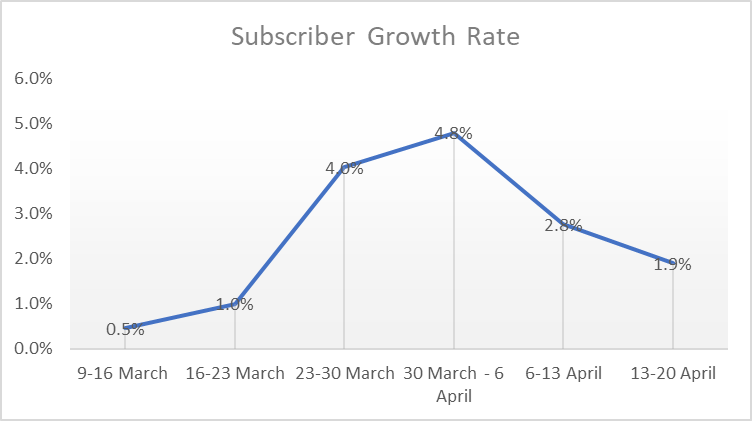This blog is part three of a four-part blog series covering the impact of COVID-19 on the media industry where we have unpacked the reasons behind the sudden growth in subscribers as shared by some of the our clients in relation to this period of lockdown and isolation.
Our previous blog shows that;
- We’ve seen a 960% rate of change in subscriber growth between March and April
- Publishing and Broadcast OTT has seen gains of >11% net growth between 9 March and 6 April 2020
- Sports OTT, on the other hand, has seen net subscriber loss of 3.4% for the same period
- US media companies have seen a 16.9% growth rate, the highest in our studies
We have subsequently added an additional 2 weeks of data to the analysis, as highlighted in the graph below, where we can see the start of the anticipated decline in growth rates for the period ending 20 April 2020.
We’ve been reaching out to some of our own clients to find out how the Coronavirus pandemic, and the resulting shift in content consumption habits, have affected their own strategies. We asked how they’ve adapted and wanted to share some of their key insights.
Publishing Key Headlines/Takeaways/Trends
The Peak Has Passed, But Subscriber Numbers Are Still Higher Than Forecasted
With the initial wave of reaction to the crisis now starting to abate, our publishing clients have some interesting and valuable insights into how they have adapted to the situation. Throughout the month of March, we saw a sharp upswing in subscription purchases, which started to show signs of slowing as we moved into April, but still far higher than forecast. This tallies with the already widely reported trend of increases in subscribers across many markets, as more people take up subscriptions to media services whilst at home. Unsurprisingly, news content is leading the way, but children’s content has seen a significant boost as well.
Coronavirus Coverage Encourages Subscriptions
Our clients have also reported an uplift in subscriptions as the front pages are dominated with news on Coronavirus – still very much the top concern for most people. This constant feed of updates is providing subscribers and potential subscribers with a reason to regularly visit digital sites and retain print subscriptions.
A Surprising Rise in Print Subscriptions And ePapers
On that topic, an increase in print and ePaper subscriptions has been a surprise for some of our clients; whilst we’ve previously talked in depth about the resurgence of print, one of the interesting areas is an increase in demand for news and media in print and ePapers. One of our clients noted that to support this demand they have had to boost the number of seats in their contact centers as well as extended their normal delivery radius to add new areas to support customers who would normally not fall under-delivery catchment areas. Like many other companies across the world supporting a large base of customers, pivoting call center staff to working remotely was one of the most difficult and costly areas of transition when the lockdown was initiated, especially for those who had previously outsourced their customer support function to off-shore call centers that were shut down overnight.
Discounts And Free Access Isn’t Always Necessary, Good Journalism is Worth Paying For
In our previous blog, we talked about using offers to provide discounts and access control functionality to offer free content to customers during these challenging times. In practice, this has been a bit more divisive with some of our clients choosing to provide offers across the board as part of their standard acquisition process, whereas others have provided free access specifically to Coronavirus content. The valid reasoning behind this is that good journalism is worth paying for – a sentiment echoed by customers. One client in particular had seen their own customers defending the subscription costs on social media when others complained, showing that subscribers clearly see the value in supporting their publishers and demonstrating a high level of brand loyalty. Low introductory offers are still prevalent, but they’re nothing new, as publishers used this same tactic successfully to encourage acquisition before lockdowns took effect.
Where paywalls have come down in some regions, registration walls certainly haven’t, which means the customer data is captured for acquisition campaigns further down the line. In a seemingly different approach, a number of our European-based publishers received government funding to support and further motivate removing paywalls on all COVID-19 related content.
One of our clients has maintained their metering rules, whereby users can view up to 13 articles for free, before being met with the paywall. The response has been that users have been able to view some articles for free to understand the value, which hasn’t harmed their subscription uptake. It has also provided the opportunity to reinforce that in subscribing to the content is supporting the organization which has been received very positively.
Retention Of New Subscribers Is The Next Big Challenge
Unsurprisingly, every digital business in the world that runs a subscription model is asking what they can do to minimize churn and maximize retention when the crisis has passed – more on this in our final part of our blog series on the Coronavirus pandemic. Our clients, of course, are no different, and are looking at tactics to retain customers.
One of the more effective strategies our clients are using is contacting customers directly, either by email or phone, to promote engagement, find out more about their needs and encourage brand loyalty. In terms of subscription cancellations, there are clients who require customers to contact them to cancel, which in turn provides another opportunity to ensure customers understand the value of the product that they are subscribed to, are using the product to its full extent, and as a last resort, offer incentives to further promote retention. There are possible regulatory changes on the horizon that could make this retention strategy more difficult if media enterprises are forced to allow consumers to cancel online.
Whilst increased contact center volumes can make proactive calls and communications to individual subscribers challenging, it’s a method that has been producing excellent results.
Physical Goods
We discussed the option of providing physical items as incentives with subscriptions. Some of our clients have, in the past, offered reading devices as part of a subscription offer, typically as a free subscription when purchasing the item or as a free device bundled into the subscription. Before the outbreak, this strategy worked very well, though it was mentioned that attempting to manage fulfilment was the biggest challenge, and that warehousing and fulfillment services such as Amazon or Apple can provide a much more streamlined process. It was also noted that this engagement strategy did not prove highly successful when it came to increasing customer lifetime value or reducing churn as most customers typically canceled the subscription after the contract term ended, however bad debt exposure was also negligible in relation to customers forfeiting on their subscription after receiving their device.
The disadvantage during the outbreak is down to increased delivery times and challenges; be aware of the perception of using non-essential items to promote services when utilizing this strategy.
OTT & Sports Key Headlines
Our clients providing OTT sports content, on the other hand, are understandably seeing significant difficulties with the cancellation of live sports.
Fan Engagement Is Key
OTT and Sports providers are looking at other ways in which to engage fans through content, and one method a client of MPP Global has chosen is to run live events on group chat like Zoom, with sports journalists, to provide interactive content for fans. Connecting with fans has been key for maintaining engagement.
Rerunning Old Events ‘as live’
Sports content is clearly still in demand from customers, but thankfully, subscribers are largely understanding that there is no new, live sport available. The strategy of re-running old content is proving popular with customers who still wish to support OTT providers. It’s not the same experience as live, but it is giving subscribers a reason to log in and, in turn, discover the additional content offerings that are being put in place.
Providing Free Months and Pausing Subscriptions
Sport will return – this is inevitable, and there are even discussions around some games going ahead in empty venues and being recorded. Our sports OTT clients have been offering subscribers free months, to retain the subscription without charge. In this way, churn is prevented, whilst customers need to take no action whilst waiting for sports to resume (or alternatives to be presented).
TVOD has seen drops in Sports subscriptions, rises everywhere else
One of our major broadcast clients has deployed a team of data scientists and BA’s to analyse the data during this time and have been reacting quickly as the situation has developed.
Customers wanting to view Sports content have either been refunded or put on subscription holidays, in much the same way as our Sports Publishers. It hasn’t all been bad news; despite no new content releases, they have reported a 40% growth across their other TVOD products against existing catalogues. This is driven largely by the same factors other clients are seeing with increased subscriber numbers due to the lockdown. Current winback offers have been performing well with careful retention strategies and targeted offers. Free trials for previous customers have been implemented to drive re-acquisition and capitalize on the growth in subscribers.
General Point: Taking Stock
One thing clients across the board raised was that the crisis was an opportunity to step back and review products and services, and take a look at what was, and wasn’t working. Particularly with clients who are running fairly new products, the current climate has allowed them to look for efficiencies, streamline and improve. This is work that may have been a nice-to-have previously, but with a sharp focus on costs to value, there may never be a better time to take stock and seriously analyse services within the market.
One example is a move from traditional servers to cloud services, where the service can be easily scaled, is managed remotely, and has fewer risks with infrastructure teams working remotely. This in turn can cut costs when needed and run a lean, effective platform.
Summary
MPP Global is fortunate as an organisation; we have a wide variety of global clients, providing different digital and physical services, which gives us a unique insight into how the subscription billing industry is coping during these challenging times. We’re also humbled and grateful to our clients for openly sharing their views with us, as it helps us to share our own ideas with the market, as well as allow our clients to share tactics and strategies with each other.
What sorts of tactics are your organisations using to retain customers and minimize churn? We’d love to have a discussion with you to hear your thoughts. Our next and final blog in this series will look at ways to use technology, process and best practice methodologies to mistime the effect of churn and defend against the possible loss of subscribers as we exit lockdown and return back to a semblance of normal.
We’re here to help
If you are reviewing your subscription strategy, get in touch to arrange a demo of how we can unlock all the tools needed to succeed now, and in the future.
Contact our helpful team; Telephone +44 844 873 1418 or visit our contact us page.





